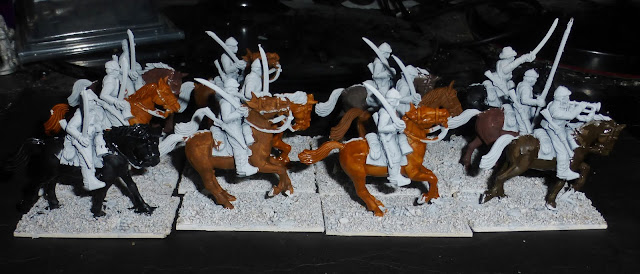One of the biggest expenses in working on a new wargaming period for me is the reference books to go with it. I usually spend more money on the accompanying books than I do on the figures.
While there have been a huge number of books written on the Texan Revoloution (compared with, say, the Latin American Wars of Independence - at least in English) there is still a huge amount of controversy about what did or didn't happen. Such uncertainty and the existence of alternative views is actually good news for a wargamer and adds to the "what if?" scenarios considerably. While always approaching my wargaming, on the whole, from a historical perspective, the Mexican's campaign in Texas lends itself to very many alternative scenarios (what if the Texans hadn't defended the Alamo? What if the weather had been better after San Jacinto and enabled a Mexican counter-attack etc.).
I have had a few books on the Alamo for some time but recently have been adding to my collection as I find reading about a particular campaign or battle keeps me focussed (as much as anything can keep me focussed, of course). So it's time for a quick tour of the Alamo library starting, in this post, with those books which I bought mainly for the illustrations.
First up (top) is the Osprey The Alamo 1836 (2001) by Stephen L Hardin, who was the historical advisor on the 2004 The Alamo film. With some atmospheric paintings by Angus McBride and excellent typical "Campaign" maps (which work particularly well on the small scale battlefields of the Alamo and San Jacinto) it's one of the best of the series.
The Alamo and the War of Texan Independence (1835-36) (1986) is the oldest of the three Ospreys on the subject. There are four pages of Texian and four pages of Mexican uniforms. The Mexican section is quite good although one picture is incorrect in showing white, not red, piping on the jacket. These pictures were almost certainly used by the sculptor producing the Boot Hill Miniatures, from the look of them.

The final Osprey on the period is Santa Anna's Mexican Army 1821-48 (2004)and is the most recent. Rene Chartrand is an expert on Mexican uniforms and has published several papers on the subject in the Company of Military Historians Journal. However, this book covers the period before the Texan Campaign as well as the Mexican-American War a decade later. The Mexicans changed their uniforms a few years before the Texan Campaign so many sources for uniform details are looking at earlier period uniforms. Chartrand's book is pretty good in describing these changes but only a couple of pages of Bill Younghusband's crisp illustrations refer to the period in question.

One of the advantages in travelling via Texas half a dozen times a year is the fact I can pick up books on The Alamo which are harder to track down (at a reasonable price, anyway) in the UK. Uniforms of the Alamo (2003) has the most detail of all the uniform books and while the illustrations aren't up to Osprey standards the text is very useful. It suffers, like many uniform books, in having an over-concentration on senior officers' uniforms.
The Alamo (2002) by Frank Thompson, who also wrote a behind the scenes of the 2004 film book, has over seventy illustrations, some of which had never been published before. It draws on a wide source of illustrations from period pictures, film stills and even comic books to illustrate its excellent summary of the siege.

























